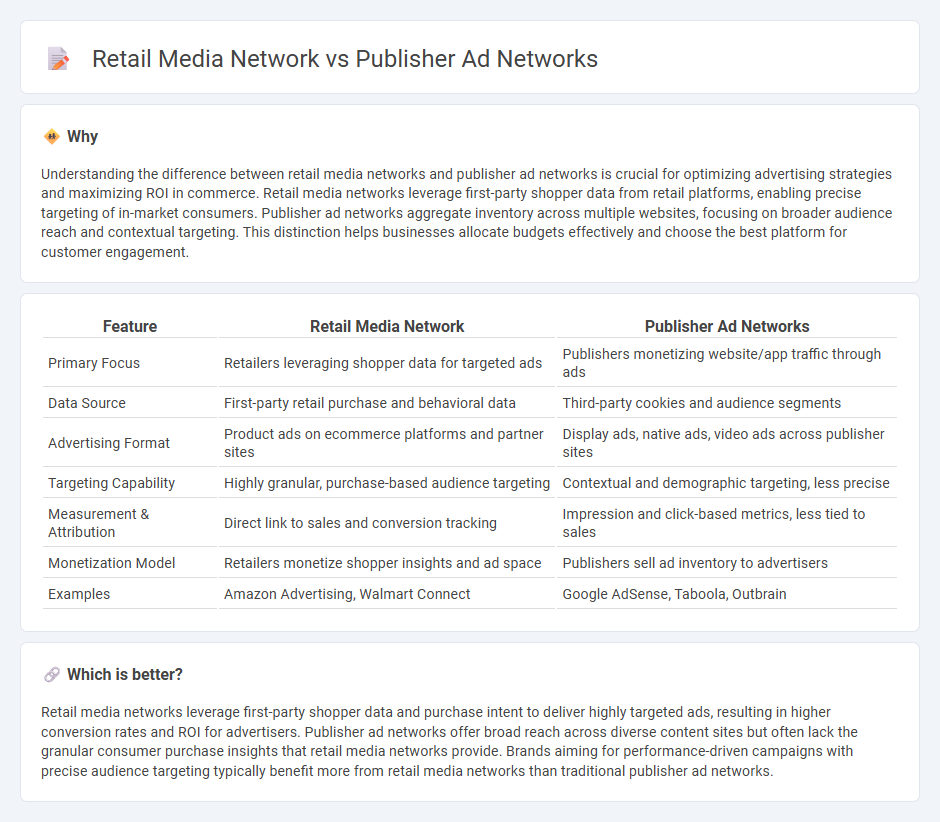
Retail media networks leverage shopper data from e-commerce platforms to deliver highly targeted ads, driving better conversion rates compared to traditional publisher ad networks that rely on broader audience segments. These networks enable brands to reach consumers at the point of purchase with personalized promotions, enhancing ROI and customer engagement. Explore how retail media networks can transform your advertising strategy for measurable growth.
Why it is important
Understanding the difference between retail media networks and publisher ad networks is crucial for optimizing advertising strategies and maximizing ROI in commerce. Retail media networks leverage first-party shopper data from retail platforms, enabling precise targeting of in-market consumers. Publisher ad networks aggregate inventory across multiple websites, focusing on broader audience reach and contextual targeting. This distinction helps businesses allocate budgets effectively and choose the best platform for customer engagement.
Comparison Table
| Feature | Retail Media Network | Publisher Ad Networks |
|---|---|---|
| Primary Focus | Retailers leveraging shopper data for targeted ads | Publishers monetizing website/app traffic through ads |
| Data Source | First-party retail purchase and behavioral data | Third-party cookies and audience segments |
| Advertising Format | Product ads on ecommerce platforms and partner sites | Display ads, native ads, video ads across publisher sites |
| Targeting Capability | Highly granular, purchase-based audience targeting | Contextual and demographic targeting, less precise |
| Measurement & Attribution | Direct link to sales and conversion tracking | Impression and click-based metrics, less tied to sales |
| Monetization Model | Retailers monetize shopper insights and ad space | Publishers sell ad inventory to advertisers |
| Examples | Amazon Advertising, Walmart Connect | Google AdSense, Taboola, Outbrain |
Which is better?
Retail media networks leverage first-party shopper data and purchase intent to deliver highly targeted ads, resulting in higher conversion rates and ROI for advertisers. Publisher ad networks offer broad reach across diverse content sites but often lack the granular consumer purchase insights that retail media networks provide. Brands aiming for performance-driven campaigns with precise audience targeting typically benefit more from retail media networks than traditional publisher ad networks.
Connection
Retail media networks leverage shopper data and purchase intent to deliver targeted ads within e-commerce environments, enhancing customer engagement and driving sales. Publisher ad networks aggregate inventory from various publishers, offering scale and diverse audience reach for advertisers. The connection lies in their complementary roles where retail media networks provide intent-driven, first-party data, while publisher ad networks extend campaign reach across multiple digital properties.
Key Terms
Inventory
Publisher ad networks primarily offer inventory sourced from a variety of third-party websites, enabling advertisers to reach diverse audiences across multiple domains. Retail media networks provide inventory exclusive to their own e-commerce platforms, delivering highly targeted ads to consumers with clear purchase intent. Explore the nuances of inventory management in these ad networks to optimize your marketing strategy.
Audience Targeting
Publisher ad networks aggregate diverse audience data across multiple content sites to enable granular targeting based on behavior, interests, and demographics, maximizing reach and relevance. Retail media networks leverage first-party shopper data, including purchase history and in-store behavior, allowing highly personalized and intent-driven ad placements that drive higher conversion rates. Explore how each network enhances audience targeting strategies to optimize your advertising impact.
Monetization Model
Publisher ad networks monetize by aggregating diverse third-party ad inventories, leveraging programmatic buying to optimize yield across multiple sites and formats. Retail media networks utilize first-party retail data to target shoppers directly on e-commerce platforms, driving higher conversion rates through personalized product ads and sales attribution. Explore the distinct monetization strategies and benefits of both ad network models for deeper insights.
Source and External Links
Top 30 Best Ad Networks for Publishers in 2025 - AdPushup - Ad networks act as intermediaries that connect publishers with advertisers, helping monetize ad inventory by efficiently matching impressions to the right buyers, with specialization in ad formats such as CPM and video ads to optimize revenue for publishers.
Ad Networks and How To Use Them | 97th Floor - Ad networks collect ad spaces from many websites and connect them to advertisers, offering publishers a streamlined way to monetize their content via various pricing models and targeting options, while complying with privacy regulations and supporting different ad formats.
10 Highest-Paying Ad Networks for Publishers - SmartyAds - The highest-paying ad networks like SmartyAds SSP, Google AdSense, and Media.net provide publishers with real-time bidding, machine learning, and multiple ad formats to maximize revenue, making the choice of ad network crucial for monetization success.
 dowidth.com
dowidth.com